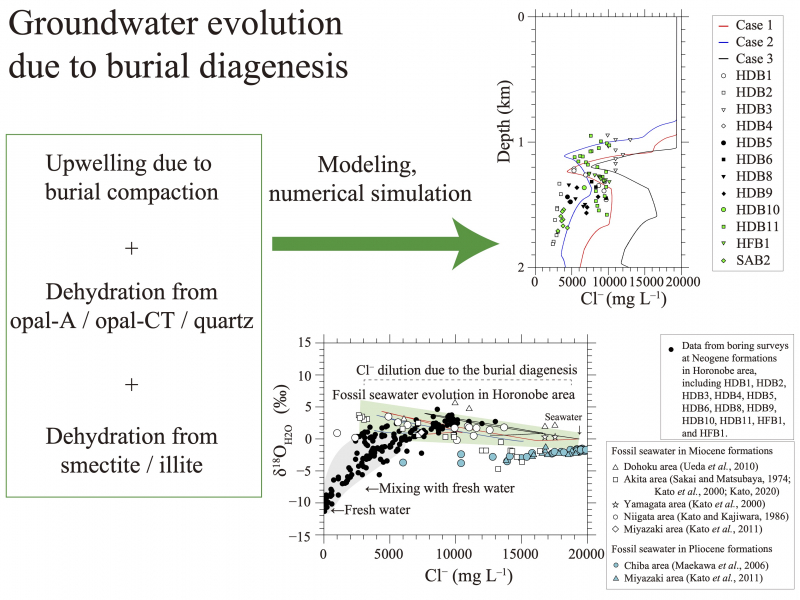
Evolution of porewater in a Neogene sedimentary formation in the Horonobe area, Hokkaido, Japan: Modeling of burial diagenesis
ABSTRACT

Low groundwater flow is essential in impeding radionuclide migration in the geological disposal of high-level radioactive waste (HLW). In the deep subsurface of thick marine sediments, groundwater may actually be ancient seawater altered during deposition and burial, termed “fossil seawater” in this study. In such cases, groundwater flow is extremely slow because it is not affected by infiltration of meteoric water, even after uplift and erosion of strata. Fossil seawater is often found in the deeper parts of the Neogene marine sedimentary Koetoi and Wakkanai Formations of the Tempoku Basin, Horonobe, northern Hokkaido, Japan. Groundwater dating using Cl isotopes and He concentration indicates that this fossil seawater may have barely moved since uplift of the area began. To confirm the low-flow nature of fossil seawater, its chemistry in the Horonobe area and burial diagenesis were investigated by numerical modeling, focusing on the effects of dehydration associated with phase transitions of biogenic silica, smectite interlayer water dehydration, and drainage and upwelling through porosity reduction. Results indicate that groundwater with δ18O values of >0‰, δ2H values of –30‰ to –20‰, and Cl– concentrations of ≤80% lower than that of seawater can be formed during burial without mixing with meteoric water. Groundwater formed during burial in the deeper parts of the Koetoi and Wakkanai Formations may thus have been preserved since uplift, confirming that fossil seawater is of extremely low mobility. The results should contribute to understanding the dilution mechanism of porewater in marine sediments and the selection of suitable site for geological disposal of high-level radioactive waste.
KEYWORDS
Keywords: burial diagenesis, biogenic silica dehydration, smectite dehydration, fossil seawater- Published : 2023
- Released on J-STAGE : 2023/10/31
- Received : 2023/03/14
- Accepted : 2023/08/28
- DOI : https://doi.org/10.2343/geochemj.GJ23014
- J-STAGE URL : https://www.jstage.jst.go.jp/article/geochemj/57/5/57_GJ23014/_article
- J-Online ISSN: 1880-5973
- Print ISSN : 0016-7002
- ISSN-L : 0016-7002
All Issues
- Vol.59, 2025
- Vol.58, 2024
- Vol.57, 2023
- Vol.56, 2022
- Vol.55, 2021
- Vol.54, 2020
- Vol.53, 2019
- Vol.52, 2018
- Vol.51, 2017
- Vol.50, 2016
- Vol.49, 2015
- Vol.48, 2014
- Vol.47, 2013
- Vol.46, 2012
- Vol.45, 2011
- Vol.44, 2010
- Vol.43, 2009
- Vol.42, 2008
- Vol.41, 2007
- Vol.40, 2006
- Vol.39, 2005
- Vol.38, 2004
- Vol.37, 2003
- Vol.36, 2002
- Vol.35, 2001
- Vol.34, 2000
- Vol.33, 1999
- Vol.32, 1998
- Vol.31, 1997
- Vol.30, 1996
- Vol.29, 1995
- Vol.28, 1994
- Vol.27, 1993
- Vol.26, 1992
- Vol.25, 1991
- Vol.24, 1990
- Vol.23, 1989
- Vol.22, 1988
- Vol.21, 1987
- Vol.20, 1986
- Vol.19, 1985-1986
- Vol.18, 1984
- Vol.17, 1983
- Vol.16, 1982
- Vol.15, 1981
- Vol.14, 1980
- Vol.13, 1979
- Vol.12, 1978
- Vol.11, 1977
- Vol.10, 1976
- Vol.9, 1975
- Vol.8, 1974
- Vol.7, 1973
- Vol.6, 1972-1973
- Vol.5, 1971
- Vol.4, 1970-1971
- Vol.3, 1969-1970
- Vol.2, 1968
- Vol.1, 1966-1967




